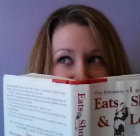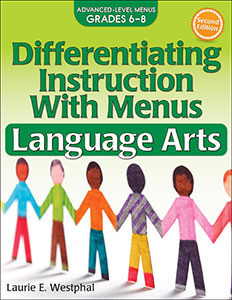Differentiating ELA Instruction with Menus
Differentiating Instruction with Menus: Language Arts Grades 6-8, 2nd Edition
By Laurie E. Westphal
(Prufrock Press Inc., 2017 – Learn more)

Any book that starts with the student quote, “Oh my gosh! THAAAAANK YOU!” shows early promise of delivering some useful instructional strategies. Laurie Westphal follows through with that promise in her book Differentiating Instruction with Menus: Language Arts Grades 6-8, 2nd Edition.

It should be noted that Prufrock Press, this book’s publishing company, is known for offering resources for gifted and advanced learners. Differentiation of product, process, or content is a cornerstone of meeting gifted children’s needs.
Menus offer a way to differentiate the products that students create. Prufrock Press offers books of menus much like this one for teachers of math, science, and social studies as well.
A strength of this language arts menu book is its organization. Differentiating Instruction with Menus is divided into two parts: “All About Menus and Choice,” which sets the stage for teachers to integrate menus into their instructional toolbox, and “The Menus” themselves. The latter section, which is nearly twice the length of the former, is a collection of ready-made menus that make for practically next-day implementation.
The 55 pages of part one can easily be consumed in a matter of hours—a quick evening or weekend project before determining which menu to implement first. Westphal is so detailed as to include lists of materials needed for students to create the products described in menus, which makes implementation just a bit easier. In fact, Westphal does much to make implementation of her menus as simple as possible.
Menus: A teacher’s best ally
Chapter 1 begins with the benefits of choice: the way it meets students’ needs, gives students a sense of independence, and more. The chapter ends with an explanation of a variety of menu types. Westphal describes the benefits and limitations of each.
In chapter 2, Westphal explains the ways menus can be used in the classroom, from building background knowledge to enrichment to curriculum compacting, which can be an especially powerful way to meet the needs of gifted students. Westphal clearly demonstrates in this chapter how menus can be a busy teacher’s best ally in meeting the needs of gifted and advanced learners in the classroom.
Chapter 3 might be the most impressive part of the book, as it culminates with lists of guidelines for students who are creating the vast array of products that Westphal includes in her menus – everything from acrostics to commercials to puppets to scrapbooks to “you be the person” presentations.
Teachers will appreciate these guidelines because they answer student questions about products, from the simplest details (“Must be 8.5 x 11 in.”) to management help (“Students must…allow teacher at least 3 days’ notice for help in obtaining a way to record the video”).
Chapter 4 focuses on rubrics because “[t]he most common reason teachers feel uncomfortable with menus is the need for fair and equal grading” (p. 49). This chapter includes an all-purpose rubric that could work for the majority of the products listed in chapter 3.
One limitation of this chapter is that it does not address standards-based grading and how menus could be scored by teachers working in standards-based grading school systems. I suspect this could be fodder for an entirely separate book. But for a teacher looking for a fast turn-around using menus, these ready-made rubrics make diving in a little less daunting.
A wide range of ready-to-use ELA menus
A page away from the rubrics session is the start of part 2, which breaks menus into four sections: genres (fiction, novel study, poetry, and more); literary analysis (plot, theme, author’s purpose, etc.); mechanics; and writing.
The mechanics label in chapter 7 is a bit misleading, as I expected it to cover more grammar, spelling, and punctuation topics. Instead, some topics covered include analogies, parts of speech, and figurative language. But this should not be a deterrent to purchasing the book, as the menus are still useful, regardless of the title.
I found the writing menus in chapter 8 to be especially intriguing because Westphal has found a way to “gamify” the writing and research processes, which could motivate reluctant writers.
Teachers working in Common Core districts will note that Westphal includes a persuasive writing menu rather than an argumentative writing menu. Despite this limitation, the menu could be adapted for argumentative writing with a little bit of work and creativity.
Each menu in part 2 includes a list of literacy objectives. While these objectives align to the Common Core State Standards, they are not labeled as such. There is, however, a note at the end of the book directing teachers to the Prufrock Press website to find more resources for aligning to the CCSS.
With its reproducible menus and immediate applicability, Differentiating Instruction with Menus is one of those books that won’t gather dust, as teachers will turn to it for quick reference often throughout the school year.
Kim Rensch is a National Board Certified Teacher who wears two hats for Fargo Public Schools in North Dakota: Middle School ELA Facilitator and Gifted Services Facilitator. Rensch is a Teacher-Consultant to the Red River Valley Writing Project and co-founder of the writing site My North Dakota Story. Her philosophy is that learning can fix the world, and literacy opens up a world of learning. She blogs for ELA colleagues at Speaking Your Language and tweets @FPSKimRensch.



































I really like this post! It is so helpful to be able to differentiate instruction for different age groups.